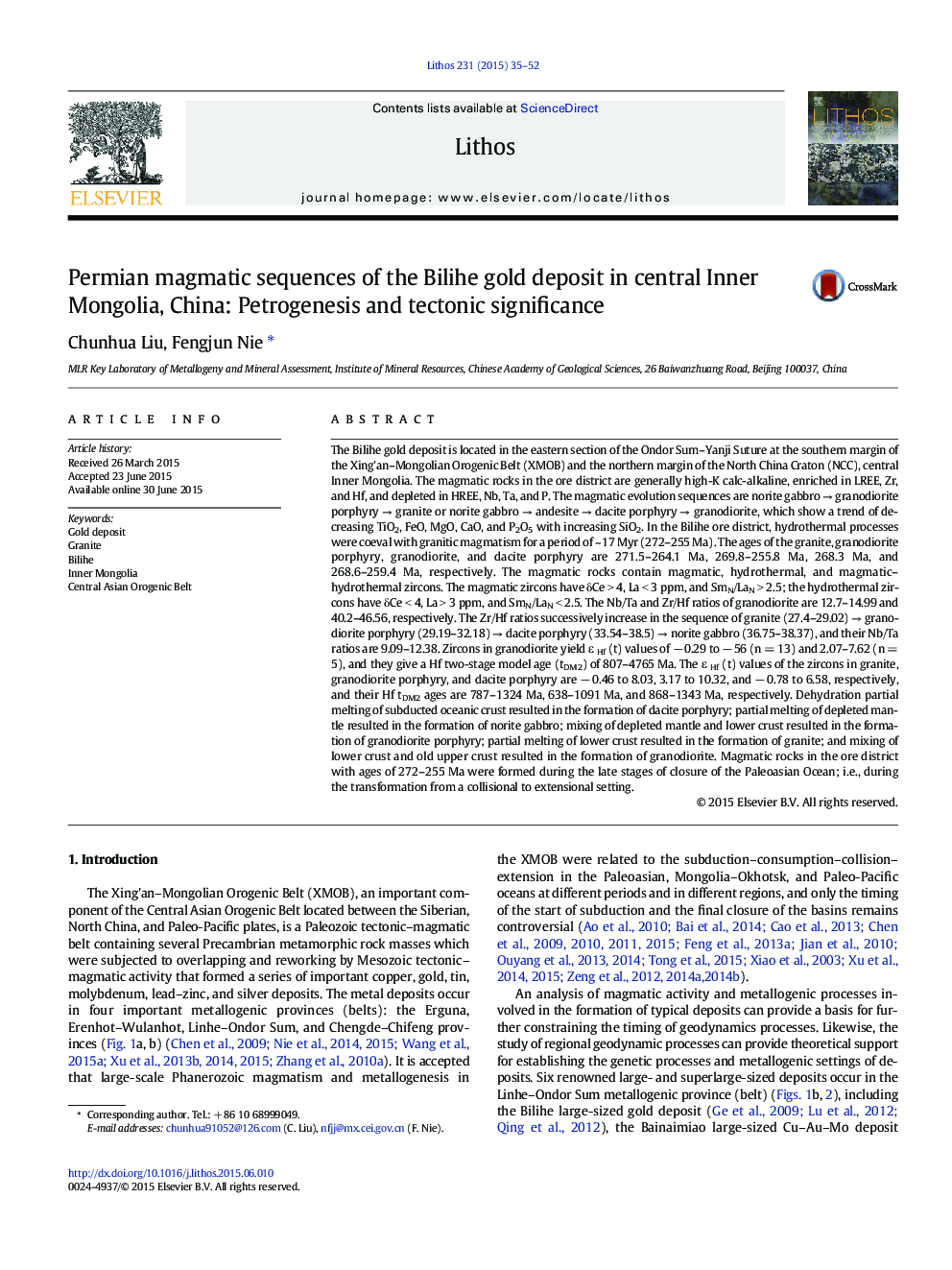| کد مقاله | کد نشریه | سال انتشار | مقاله انگلیسی | نسخه تمام متن |
|---|---|---|---|---|
| 4715633 | 1638660 | 2015 | 18 صفحه PDF | دانلود رایگان |

• A set of basic–intermediate–acidic magmatic sequences are developed in Bilihe district.
• Magmatic rocks contain magmatic, hydrothermal, and magmatic–hydrothermal zircons.
• Hydrothermal processes were coeval with granitic magmatism during 272–255 Ma.
The Bilihe gold deposit is located in the eastern section of the Ondor Sum–Yanji Suture at the southern margin of the Xing'an–Mongolian Orogenic Belt (XMOB) and the northern margin of the North China Craton (NCC), central Inner Mongolia. The magmatic rocks in the ore district are generally high-K calc-alkaline, enriched in LREE, Zr, and Hf, and depleted in HREE, Nb, Ta, and P. The magmatic evolution sequences are norite gabbro → granodiorite porphyry → granite or norite gabbro → andesite → dacite porphyry → granodiorite, which show a trend of decreasing TiO2, FeO, MgO, CaO, and P2O5 with increasing SiO2. In the Bilihe ore district, hydrothermal processes were coeval with granitic magmatism for a period of ~ 17 Myr (272–255 Ma). The ages of the granite, granodiorite porphyry, granodiorite, and dacite porphyry are 271.5–264.1 Ma, 269.8–255.8 Ma, 268.3 Ma, and 268.6–259.4 Ma, respectively. The magmatic rocks contain magmatic, hydrothermal, and magmatic–hydrothermal zircons. The magmatic zircons have δCe > 4, La < 3 ppm, and SmN/LaN > 2.5; the hydrothermal zircons have δCe < 4, La > 3 ppm, and SmN/LaN < 2.5. The Nb/Ta and Zr/Hf ratios of granodiorite are 12.7–14.99 and 40.2–46.56, respectively. The Zr/Hf ratios successively increase in the sequence of granite (27.4–29.02) → granodiorite porphyry (29.19–32.18) → dacite porphyry (33.54–38.5) → norite gabbro (36.75–38.37), and their Nb/Ta ratios are 9.09–12.38. Zircons in granodiorite yield ε Hf (t) values of − 0.29 to − 56 (n = 13) and 2.07–7.62 (n = 5), and they give a Hf two-stage model age (tDM2) of 807–4765 Ma. The ε Hf (t) values of the zircons in granite, granodiorite porphyry, and dacite porphyry are − 0.46 to 8.03, 3.17 to 10.32, and − 0.78 to 6.58, respectively, and their Hf tDM2 ages are 787–1324 Ma, 638–1091 Ma, and 868–1343 Ma, respectively. Dehydration partial melting of subducted oceanic crust resulted in the formation of dacite porphyry; partial melting of depleted mantle resulted in the formation of norite gabbro; mixing of depleted mantle and lower crust resulted in the formation of granodiorite porphyry; partial melting of lower crust resulted in the formation of granite; and mixing of lower crust and old upper crust resulted in the formation of granodiorite. Magmatic rocks in the ore district with ages of 272–255 Ma were formed during the late stages of closure of the Paleoasian Ocean; i.e., during the transformation from a collisional to extensional setting.
Figure optionsDownload as PowerPoint slide
Journal: Lithos - Volume 231, 15 August 2015, Pages 35–52